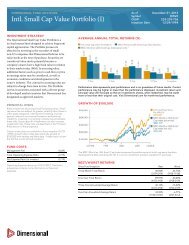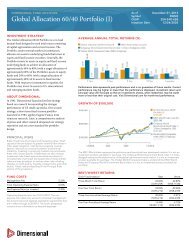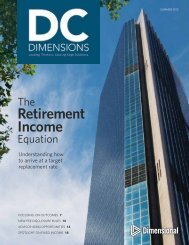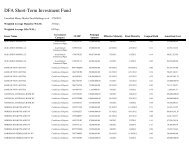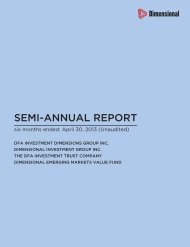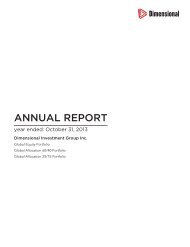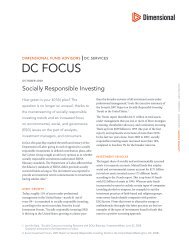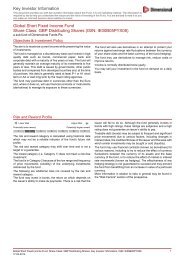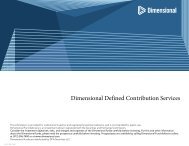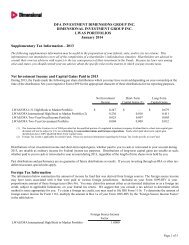Rebalancing and Returns.indd - Dimensional Fund Advisors
Rebalancing and Returns.indd - Dimensional Fund Advisors
Rebalancing and Returns.indd - Dimensional Fund Advisors
Create successful ePaper yourself
Turn your PDF publications into a flip-book with our unique Google optimized e-Paper software.
<strong>Rebalancing</strong> <strong>and</strong> <strong>Returns</strong> 13<br />
I conduct a second out-of-sample test using data from January 2005 to July 2008.<br />
The allocation is the same as in Tables 1-3; <strong>and</strong> the annualized arithmetic average net<br />
returns, averaged over the 12 monthly starts, are displayed in Table 5. The optimal<br />
strategies add about 7 basis points over the benchmark (60, 10%) strategy <strong>and</strong> about<br />
35 basis points over no rebalancing. However, in this sample, the best three strategies<br />
are the (1, 5%), the (250, 0%), <strong>and</strong> the (10, 10%). The previous winner, the (1, 20%)<br />
strategy, now ranks only 27th out of 42. Moreover, the best strategies appear almost<br />
r<strong>and</strong>om, which is what one would expect if return differences across strategies were<br />
mainly driven by noise in returns. Panel B, which displays the difference in return relative<br />
to the benchmark (60, 10%) strategy, supports this. Except for the (1, 0%) strategy,<br />
which has abysmal returns because of frequent, costly trading, none of the strategies<br />
has returns that significantly differ from the benchmark strategy.<br />
The returns for the core <strong>and</strong> component portfolios in this later sample are displayed in<br />
Table 6. 7 Once again, the (1, 20%) rebalancing strategy does not produce the highest<br />
returns. Comparing the core <strong>and</strong> component portfolios in Panel C, the core outperformed<br />
the component strategies for 9 of the 42 strategies, although, with the exception<br />
of the (1, 0%) strategy, these differences are all statistically insignificant. The largest<br />
return difference occurred with the (1, 10%) strategy, which gave the component portfolio<br />
a 9 basis point advantage over core. However, in the previous period, the return<br />
advantage using the (1, 10%) strategy was the opposite, with the core portfolio having<br />
a return about 20 basis points higher than the component portfolio. There is simply no<br />
empirical evidence to support the idea that breaking asset classes into smaller components<br />
can produce reliably higher returns through rebalancing opportunities.<br />
Is There a <strong>Rebalancing</strong> Return Benefit<br />
In both of the periods examined so far, the non-rebalanced portfolio has experienced<br />
lower returns than any of the rebalanced portfolios. Even if there is no single rebalancing<br />
strategy that will produce the highest returns for every portfolio in every period, can<br />
this be interpreted as evidence that rebalancing in general produces some return benefit<br />
Again, 11.5 years is a fairly short period of time when dealing with noisy historical returns.<br />
Thus, to empirically test whether rebalancing in general has return benefits over<br />
not rebalancing, I obtain monthly US stock <strong>and</strong> bond data from July 1926 to June 2008.<br />
I form a portfolio in July 1926 with 60% in equities <strong>and</strong> 40% in bonds. The equity<br />
portion combines six Fama/French portfolios formed on size <strong>and</strong> book-to-market, with<br />
weights of 12% in each of three large capitalization portfolios (Large Value, Large Neutral,<br />
<strong>and</strong> Large Growth), <strong>and</strong> 8% in each of three small capitalization portfolios (Small<br />
7. As in the previous sample, the component weights are determined by their average weights in the<br />
year prior to portfolio formation, from January 2004 to December 2004. Specifically, the Russell 1000<br />
Value, the Russell 1000 Growth, the Russell 2000 Value, <strong>and</strong> the Russell 2000 Growth had weights of<br />
42.30%, 45.75%, 5.00%, <strong>and</strong> 6.95% respectively. These weights were scaled to sum to 45%.



